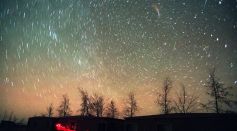Tags: Star
Ideal Iron Conditions Needed for Life to Strive on Earth and Other Planets
Animal Magnetism: Male Spiders Orbit a Cannibalistic Female Spider Like Planets Orbiting a Star to Search a Mate
Weird Galaxy Without Dark Matter Baffles Astronomers As It Contradicts Popular Beliefs About the Universe
Fermi Paradox Explained: Are We Alone in the Universe? Is Drake Equation the Solution?

Gas Giant Planets Like Jupiter, Saturn Orbiting V1298 Tau Star Could Reach Final Size At Very Early Stages of Evolution
Debris Disk Around Main-Sequence Star Can Help Scientists Find New Exoplanets When Asteroids Collide

Some Brightest Stars in the Night Sky Are Megconstellation, Man-Made Satellites May Disrupt Astronomy Research

NASA Telescope Sees Merger of Two Black Holes That Could Cast Doubt on Laws of Physics

NASA James Webb Space Telescope is About to Depart a Month From Now to Find the Unexpected
Will NASA Hubble Space Telescope Finally Wake Up After Space Agency Renews Its $215-Million Working Contract?

The Worlds Next Door: Looking For Habitable Planets Around Alpha Centauri
NASA Hubble Space Telescope Captures an Inky-Black Nebula, Newly Forming Star
German Scientists Identified the First Deeply Eclipsing Stream-Fed Intermediate Polar Located Between 4,200-9,300 Light-Years Away

NASA Hubble Space Telescope Shares Festive Photo of Snowman Nebula

Leonid Meteor Shower 2021: How, Where To Watch This Most Historical Event Soon

Stars of Galaxy Charted 12 Billion Light-Years Away Contains Same Element Inside Human Bones, Toothpaste
Are Black Holes Scarier Than a Ghost? 5 Fun Facts About Them

NASA Chandra X-Ray Observatory Telescope Finds Signs of First Planet Found Outside Milky Way
Hubble Space Telescope Found Two Interacting Galaxies 200 Million Light-Years Away
NASA Hubble Space Telescope Witnesses Death of a Star; Is This a Warning Sign?
Most Popular

Viruses vs Bacteria: Key Differences, How They Spread, and How We Treat Them

Science-Backed Longevity Supplements: The Best Anti-Aging Vitamins for Powerful Healthy Aging Support

Carbon Footprint 101: What It Is and Simple Ways to Reduce Yours

How Ice Cores Reveal Climate History: Insights from Paleoclimate Science and Ancient Data




